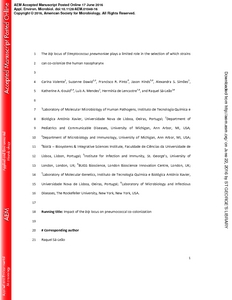Valente, C; Dawid, S; Pinto, FR; Hinds, J; Simões, AS; Gould, KA; Mendes, LA; de Lencastre, H; Sá-Leão, R
(2016)
The blp locus of Streptococcus pneumoniae plays a limited role in the selection of which strains can co-colonize the human nasopharynx.
Applied and Environmental Microbiology, 82 (17).
pp. 5206-5215.
ISSN 1098-5336
https://doi.org/10.1128/AEM.01048-16
SGUL Authors: Hinds, Jason
![[img]](https://openaccess.sgul.ac.uk/107987/1.hassmallThumbnailVersion/Appl.%20Environ.%20Microbiol.-2016-Valente-AEM.01048-16.pdf)  Preview |
|
PDF
Accepted Version
Available under License ["licenses_description_publisher" not defined].
Download (1MB)
| Preview
|
Abstract
Nasopharyngeal colonization is important for Streptococcus pneumoniae evolution, providing the opportunity for horizontal gene transfer when multiple strains co-occur. Although colonization with more than one strain of pneumococcus is common, the factors that influence the ability of strains to co-exist are not known. A highly variable blp (bacteriocin-like peptide) locus has been identified in all sequenced strains of S. pneumoniae This locus controls the regulation and secretion of bacteriocins, small peptides that target other bacteria. In this study, we analyzed a series of co-colonizing isolates to evaluate the impact of the blp locus on human colonization to determine whether competitive phenotypes of bacteriocin secretion restrict co-colonization.We identified a collection of 135 nasopharyngeal samples with two or more strains totaling 285 isolates. The blp locus of all strains was characterized genetically with regards to pheromone type, bacteriocin/immunity content and potential for locus functionality. Inhibitory phenotypes of bacteriocin secretion and locus activity were assessed through overlay assays. Isolates from single colonization (n=298) were characterized for comparison.Co-colonizing strains had a high diversity of blp cassettes; approximately one third displayed an inhibitory phenotype in vitro Despite in vitro evidence of competition, pneumococci co-colonized individuals independently of their blp pheromone type (p=0.577), bacteriocin/immunity content, blp locus activity (p=0.798) and inhibitory phenotype (p=0.716). In addition, no significant differences were observed when single and co-colonizing strains were compared.Despite clear evidence of blp-mediated competition in experimental models, our study suggests that the blp locus plays a limited role in restricting pneumococcal co-colonization in humans. IMPORTANCE: Nasopharyngeal colonization with Streptococcus pneumoniae (pneumococcus) is important for pneumococcal evolution as it represents the major site for horizontal gene transfer when multiple strains co-occur, a phenomenon known as co-colonization. Understanding how pneumococcal strains interact within the competitive environment of the nasopharynx is of chief importance in the context of pneumococcal ecology. In this study we used an unbiased collection of naturally co-occurring pneumococcal strains and showed that a biological process frequently used by bacteria for competition - bacteriocin production - is not decisive in the co-existence of pneumococci in the host, contrary to what has been shown in experimental models.
Statistics
Item downloaded times since 03 Aug 2016.
Actions (login required)
 |
Edit Item |



